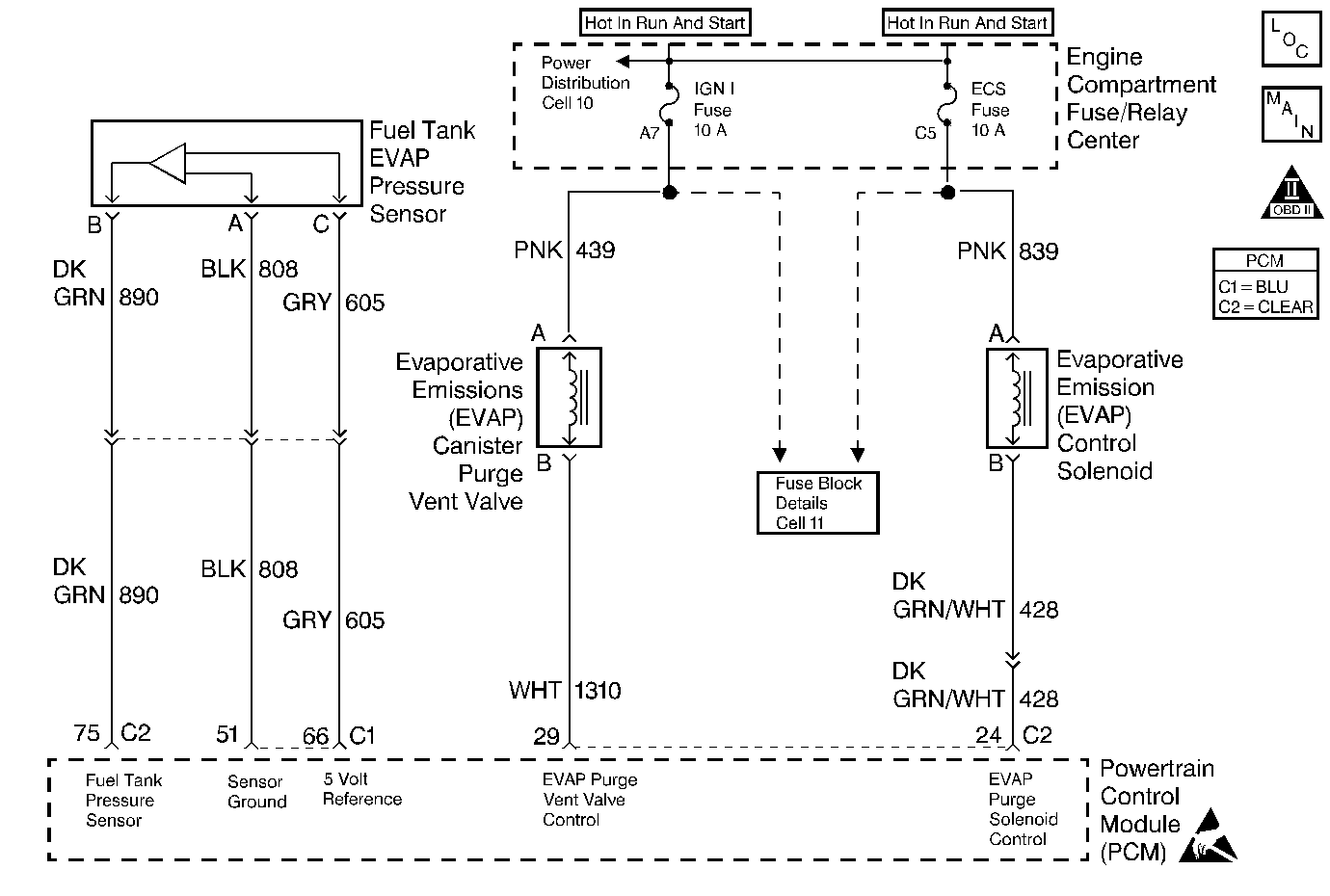
Circuit Description
The EVAP Fuel Tank Pressure sensor is a sensor that changes resistance based upon fuel tank pressure (or vacuum). A vacuum is considered negative pressure.
The PCM provides a 5 volt reference and ground. The EVAP Fuel Tank Pressure sensor signal varies between ground and 5 volts as fuel tank pressure varies. As pressure decreases (negative pressure, or vacuum), voltage increases. As pressure increases, voltage decreases (positive pressure, low voltage). The PCM uses the EVAP Fuel Tank Pressure sensor values as an indicator of EVAP system efficiency. If the EVAP Fuel Tank Pressure sensor signal goes high such as when the signal line is shorted to voltage or the EVAP Fuel Tank Pressure sensor is shorted internally, this DTC will set.
Conditions for Running the DTC
| • | DTC P0601 is not set. |
| • | Fuel level at engine start up is the same or less than 85% full. |
| • | The Intake Air Temperature (IAT) at engine start up is between 2°C and 60°C. |
Conditions for Setting the DTC
The EVAP Pressure sensor reading has been 4.80 volts or higher.
Action Taken When the DTC Sets
PCM disables Evaporative Emission (EVAP) control solenoid.
| • | The PCM will illuminate the malfunction indicator lamp (MIL) when the diagnostic runs and fails. |
| • | The PCM will record operating conditions at the time the diagnostic fails. This information will be stored in the Freeze Frame and Failure Records. |
Conditions for Clearing the MIL/DTC
| • | The PCM will turn the MIL OFF after three consecutive drive trips that the diagnostic runs and does not fail. |
| • | A Last Test Failed (current) DTC will clear when the diagnostic runs and does not fail. |
| • | A History DTC will clear after forty consecutive warm-up cycles with no failures of any emission related diagnostic test. |
| • | Use a scan tool to clear DTCs. |
| • | Interrupting PCM battery voltage may or may not clear DTCs. This practice is not recommended. Refer to Clearing Diagnostic Trouble Codes in PCM Description and Operation. |
Diagnostic Aids
The EVAP Fuel Tank Pressure Sensor monitors a range from 7.5 in. H2O of pressure to -17.5 in. H2O of pressure (vacuum).
The vacuum and pressure in the EVAP system is measured in inches of water (H2O). Most gauges measure vacuum in inches of mercury (Hg) and pressure in pounds per square inch (psi). The following shows how the values compare:
in H2O | in Hg | psi |
|---|---|---|
1in H2O | 0.07 in Hg | 0.0361 psi |
5 in H2O | 0.36 in Hg | 0.180 psi |
10 in H2O | 0.73 in Hg | 0.361 psi |
15 in H2O | 1.10 in Hg | 0.541 psi |
Test Description
Number(s) below refer to the step number(s) on the Diagnostic Table.
-
If the EVAP Fuel Tank Pressure sensor value is greater than 4.80 volts, an EVAP Fuel Tank Pressure sensor circuit problem must be present.
-
If the EVAP Fuel Tank Pressure sensor value is less than 0.10 volts, the fault is the EVAP Fuel Tank Pressure sensor or the reference voltage is higher than 5.00 volts.
-
A high voltage reading on the 5 volt reference circuit could be caused by a short to voltage on another 5 volt reference circuit, some 5V Ref. circuits are shared inside and outside the PCM. A defective Linear EGR Valve may bleed battery voltage onto the 5 volt reference circuit.
Step | Action | Value(s) | Yes | No |
|---|---|---|---|---|
1 | Did you perform the Powertrain On-Board Diagnostic (OBD) System Check? | -- | ||
Is the value greater than the value specified? | 4.80 volts | Go to Diagnostic Aids | ||
Disconnect the EVAP Fuel Tank Pressure sensor connector. Is the EVAP Fuel Tank Pressure sensor display less than the value specified? | 0.10 volts | |||
4 | Using DMM J 39200 measure the voltage to ground of the 5 volt reference circuit at the EVAP Fuel Tank Pressure sensor connector. Is the voltage higher than the value specified? | 5.50 volts | ||
5 | Using DMM J 39200 measure the voltage to ground of the sensor Signal circuit at the EVAP Fuel Tank Pressure sensor connector. Is the voltage higher than the value specified? | 0.5 volts | ||
6 | Repair the short to voltage on the EVAP Fuel Tank Pressure sensor Signal circuit. Is the repair complete? | -- | -- | |
Repair the short to voltage on the 5 Volt Reference circuit. Refer to Test Descriptions. Is the repair complete? | -- | -- | ||
8 |
Was terminal contact repaired? | -- | ||
9 | Replace the EVAP Fuel Tank Pressure sensor. Refer to Fuel Tank Pressure Sensor Replacement . Is the replacement complete? | -- | -- | |
10 |
Was terminal contact repaired? | -- | ||
11 | Replace the PCM. Refer to Powertrain Control Module Replacement/Programming . Is the replacement complete? | -- | -- |
